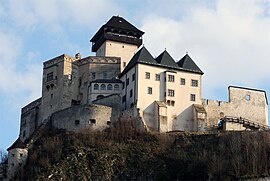Treaty of Trentschin
| Trenčínská smlouva (cs) Układ w Trenczynie (pl) Trencséni megegyezés (hu) | |
|---|---|
 Trenčín Castle | |
| Signed | 24 August 1335 |
| Location | Trencsén Castle, Hungary |
| Effective | 9 February 1339 |
| Condition | Ratification by King Casimir III |
| Signatories | |
The Treaty of Trencin was concluded on 24 August 1335 between King
Prelude

Shortly before his death in 992,
In 1280 Duke
In 1305 King Wenceslaus II died and his son
The treaty

In 1333 the Polish king Władysław was succeeded by his son Casimir III. He was prepared to compromise. Casimir III resorted to sue the Teutonic Order at the Roman Curia and settled the rising conflict with King John of Bohemia by the provisory Trentschin treaty on St Bartholomew's Day 1335. The representatives of the Polish king, in perpetuity, renounced all claims to Silesia in favour of Bohemia while King John and his son Charles in turn finally waived their claims to the Polish throne derived from the Přemyslids.[2] The agreement was to be confirmed, when the rulers met at the Congress of Visegrád later in November 1335.
King John now had a free hand to continue vassalizing the Silesian duchies of
Bolko II the Small remained the only Silesian duke, who was not content to accept Bohemian overlordship. However, he had no male heirs and his niece Anna von Schweidnitz married Emperor Charles IV in 1353. He signed an inheritance treaty whereupon the death of his widow Agnes of Austria, 1392, the Duchy of Jawor would finally fall to Bohemia.
Aftermath

With the Treaty of Trentschin, the split of Silesia from the Polish Crown was made. In 1348 King Charles IV attached it to the Bohemian crown lands together with Moravia and the Lusatias. The Silesian dukes became indirect vassals of the Holy Roman Empire with no immediate status and no representation at the Imperial Diet. According to canon law, the Diocese of Wrocław remained a suffragan of the Polish Archdiocese of Gniezno. While the Silesian lands also comprised the former Moravian Duchy of Opava, the Upper Silesian duchies of Siewierz, Oświęcim and Zator were acquired by Poland in the 15th century. The Lower Silesian duchy of Krosno fell to Brandenburg in 1476.
Upon the death of the Bohemian king
The surrender of Silesia by Casimir established a border that remained stable and in effect until after World War I.[3]
See also
- History of Silesia
- Congress of Visegrád (1335)
- Treaty of Namslau
References
- ^ Kaps, Johannes (1952). The tragedy of Silesia, 1945-1946: a documentary account with a special survey of the Archdiocese of Breslau. Christ Unterwegs. p. 23.
- ISBN 978-1-136-96016-1.
- ISBN 978-1-107-02073-3.
